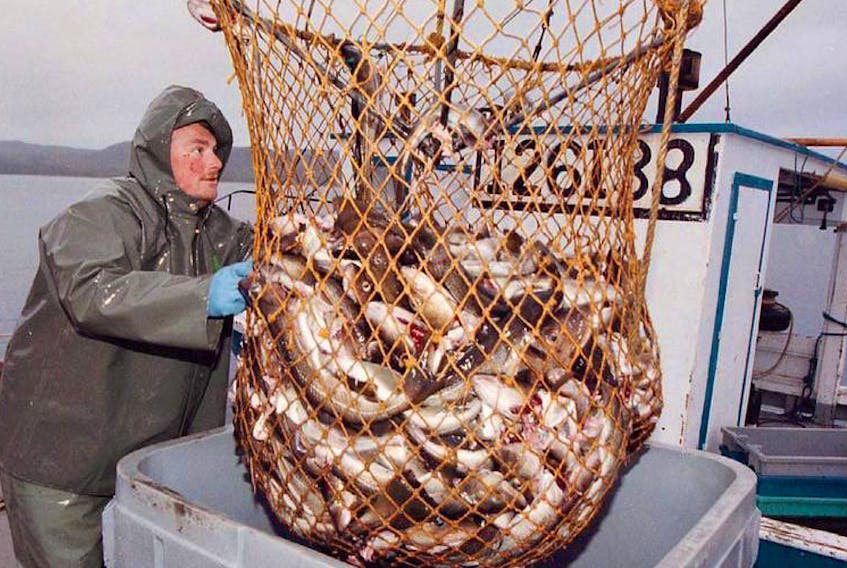BRUSSELS, BELGIUM - As trade grows between Canada and the European Union (EU), the results of this international partnership are washing ashore in fishing outports across the province.
The fishery, which was historically the economic foundation of Newfoundland and Labrador, is today an industry continuously beset by cuts, declines and uncertainties. But in recent years, words of hope and rebound are growing in the public discourse.
With tariffs declining and opportunities arising, the Comprehensive Economic and Trade Agreement (CETA) between Canada and the EU has the potential to play a key role in the livelihoods of harvesters and processors.
Now one year after this international trade agreement took effect, the fishing industry is seeing changes.
Shrimp: Renewed work
The outport of Port au Choix is one community already reaping the benefits of CETA. After severe cuts in the northern shrimp quota, the Ocean Choice International shrimp plant in the Northern Peninsula town had struggled in recent summers.
However, since CETA has ended the 12 per cent tariff on cooked shell-on shrimp going into the European market, processed shrimp production has increased for the Port au Choix plant.
“Instead of shipping the shrimp unprocessed, the Port au Choix facility has now taken industrial processing onshore,” said Fisheries and Land Resources Minister Gerry Byrne in an interview with The Central Voice. “It’s created jobs and improved processing for that area. That would have never been possible without CETA.”
Assistant trade policy officer with the EU Clare Murphy was directly involved with CETA negotiations in its beginning years, researching the tariffs and trade flow of Canada’s fishery products into their market.
Southeast Asia is a major importer of shrimp into the European market, but with more processed Canadian shrimp entering the continent, Murphy says the quality of cold-water northern shrimp can make it stand out on the market.
“We import a lot of shrimp, and this was important to Canada during the negotiations,” she said. “Sustainability, environmental concerns, organic products, etc. – this has become a more widespread issue to consumers in Europe.
“That is a potential market because southeast Asian shrimp is generally farmed and not always in those categories.”
WHY CETA MATTERS
The European Union has a population of more than 500 million people and annual GDP in the trillions of dollars.
CETA gives Canadian businesses access to the world’s largest single market by eliminating a variety of tariffs on good and services. It was provisionally applied Sept 27, 2017, eliminating 98% of the tariffs on Canadian exports to the EU.
Cod: Marketing of a premium product
Twillingate fisherman John Gillett has made his living on the Atlantic waters for over 50 years, including through the tumultuous collapse of the cod fishery in the 1990s. At that time, the plant in Twillingate was restructured as a shrimp plant because of the cod moratorium. But in 2017, Twillingate was hit again with a major economic loss after the closure of the Notre Dame Seafoods shrimp plant.
With the talk of a rebounding cod fishery, incentives created through CETA and new investments through the Atlantic Fisheries Fund, Gillett hopes there is still a future for the area’s fishery and its plant.
“During the moratorium it was devastating, and back then there was a lot of money invested that was wasted away,” Gillett said. “I’ve never seen the codfish as plentiful as it is now, and with all that’s coming through CETA–I hope things are done right and there’s a future for that plant.”
In the EU, cod is imported largely from Iceland and Norway, and is also a fishery for some EU countries like Spain.
Murphy says cod is a product highly sought after in the European market, and if the quality is high enough, Canadian cod can compete.
Now that the agreement is in effect, she says it is really up to the companies and harvesters of the province to find the advantages and make the most of this new trade relationship.
“It’s in their interest to explore possibilities,” Murphy said. “We’re one of the biggest markets for fishery products, so the potential is there. A good quality product from a sustainable fishery is certainly important now.”
Just this past year cod harvesters across Newfoundland and Labrador were awarded funding for automatic line jiggers for their vessels. This technology, prominently used in the fisheries of Iceland and Norway, is known for its ability to catch cod efficiently and ensure high quality.
“Hopefully it’s going to make a big difference in the fishery; we have to be able to get into this new way of fishing,” said Mary’s Harbour fisherman Alton Rumbolt, who received funding for this new technology in January. “We’re aiming for top quality product and a better price.”
While Icewater Seafoods in Arnold’s Cove already sends cod to the EU and United Kingdom, Byrne agrees it is with a quality product that Newfoundland and Labrador’s cod fishery will grow its place in the EU.
“We’re in the European market for premium cod – the marketplace really picks up on that distinction,” Rumbolt said. “We have to make sure we have the best practices.”
Lobster and redfish: Growing exports
One year on, both Canada and the EU made overall increases in exports and imports. But thus far, the European Union has taken greater advantage of CETA. Since the trade agreement went into effect, imports into Canada from the EU have risen by 12 per cent (according to data from Statistics Canada). Between October 2017 and July 2018, European imports of vehicles and vehicle parts increased by 15.5 per cent, pharmaceutical imports increased by 6.2 per cent, and fuel and oil imports went up by 21.9 per cent. However, in the first 10 months of CETA, Canada’s exports into Europe have only gone up by less than one per cent. Paul Brannen, European Parliament MEP and vice-chair of the Delegation for Relations with Canada, says Europe is in a much stronger position for trade because of its larger population. “
It is a relationship of unequals with such a larger market in Europe,” Brannen said. “The hard evidence numbers of how things have changed since CETA will take three or four years before we can say definitively, but the indication is that it will have a net benefit for both the EU and Canada.”
However, some fishery exports have made their debut in the EU with the implementation of CETA. According to Byrne, since the elimination of a 7.5 per cent tariff on redfish, the product was exported into the European market for the first time this year. This fishery in particular is a growing resource for Newfoundland and Labrador, with stocks of redfish becoming more prominent on the west coast of the island.
Fish, Food and Allied Workers (FFAW) union representative Jason Spingle expects this will soon become a major fishery for harvesters in the area. In 2017, the processing company Barry Group and Cos. signed a deal with the Qalipu Mi’kmaq First Nation Band to harvest redfish along western Newfoundland. The quota is not expected to be allocated until 2019.
“We have to do a lot more to show people what is possible and a lot of companies need experience and trust in this. We should open the markets and the companies should seek customers and see what areas are most successful.”
-MEP and chair of the Delegation for Relations with Canada Bernrd Kölmel
In her routine trips to the grocery stores of Brussels, Murphy has noticed an increase in Canadian lobster on their shelves. She says lobster is a seasonal product for Europeans, and there may be a huge jump in export during the holiday season in December.
Executive director of the Lobster Council of Canada Geoff Irvine is looking forward to what those end-of-year exports for Canadian lobster to Europe will yield.
In the council’s numbers for August of 2017 and 2018, exports for Canadian lobster already experienced a considerable increase in some countries. In Spain, over 61,500 kilograms of lobster were imported in August of 2017 and over 274,000 kilograms were imported this August. In France, the numbers went from 135,000 kilograms in 2017 to over 183,000 kilograms in 2018 in the same month. Hungary, an EU member state that imported no Canadian lobster in August of 2017, imported over 24,000 kilograms this year.
On Nov. 21, Canada’s Finance Minister Bill Morneau released a fall economic statement that called for a new strategy to boost Canada’s oversea exports 50 per cent by 2025.
MEP and chair of the Delegation for Relations with Canada Bernrd Kölmel sees that one way to bring more Canadian exports into Europe is to ensure brochures are available, detailing where tariffs have been cut and what products are most needed. This way companies can better know what opportunities they can capitalize on.
“We have to do a lot more to show people what is possible and a lot of companies need experience and trust in this,” said Kölmel. “We should open the markets and the companies should seek customers and see what areas are most successful.”

Processing requirements and other product potential
For Newfoundland and Labrador, one area of contention was the loss of minimum processing requirements as tariffs on fishery products are reduced.
In exchange for removing the tariffs on fishery products, the province would also see a cut in the minimum amount of raw material that had to be processed in Newfoundland and Labrador. Because it meant the possibility of less material being processed in the province and increased hardship on plants already struggling for material, this caused conflict during negotiations.
According to Byrne, thus far there has been no movement of unprocessed fishery products into Europe and he expects this trend will likely continue into the future.
“It was a big question of our sovereignty being lost,” said Byrne. “Fish would be leaving the province in bulk unprocessed into the EU market. But for quality and for cost reasons, the threat of having unprocessed fish leaving Newfoundland and Labrador is really not significant.”
When interviewed in April of 2018, Sam Elliott of St. Anthony Basin Resources, Inc. noted the loss of minimum processing requirements could incentivize plants to improve processing capabilities within the province.
“To take something from here and carry it across an ocean to be processed, if you’re going to try and do it in a fresh state, there’s timelines and you’re working against the clock,” Elliott said. “If they’ve got the technology to take our product and maintain the quality in the time it takes to produce it and put it to market, then we should be able to figure out what that technology is and do it better.”
Byrne says the Department of Fisheries and Land Resources is also looking into other potential markets, such as snow crab, and less used products like seaweed or blue muscles.
“Some of these products, like sea urchins or sea cucumbers, have even stronger value in the Asian market,” said Byrne. “So we have to target products that have the most potential and pre-existing interest in each area. Volume is as important as price, and if our markets are too spread out, we may find ourselves in less competitive situations.”
The future of EU-Canada relations
The European Union is faced with potentially major changes, from the United Kingdom leaving the union through the Brexit referendum, to the rise of populist and right-wing parties calling for a more de-centralized EU.
“Canada gets talked about much in the British media now. There’s variations on the idea of replicating the trade deal struck with the EU and Canada as the kind of trade deal we would have once we leave.”
-European Parliament MEP and vice-chair of the Delegation for Relations with Canada, Paul Brannen,
However, Kölmel says Canada’s relationship with EU remains a bedrock for the institution, and it is very unlikely trade will be affected by any of these changes.
The success of CETA has also become a talking point during Brexit negotiations, particularly around using CETA as a blueprint for the United Kingdom’s future relationship with the EU.
“Canada gets talked about much in the British media now,” Brannen said, who will be leaving his seat in the European Parliament once the UK departs the union. “There’s variations on the idea of replicating the trade deal struck with the EU and Canada as the kind of trade deal we would have once we leave.”
Currently the United Kingdom is the main European partner for Canadian trade, and Brexit will mean a renegotiation of the UK’s relationship with the country.
“As it stands we’ll default on WTO (World Trade Organization) terms, and then we have to go through the products to see what this means,” Brannen said. “It’ll be back to square one, we have to negotiate as the UK alone our relationship with Canada. It’s possible there will be tighter relations with the commonwealth nations.”
RELATED
Tell us what you think!
Write us a letter to the editor and email it to [email protected]. Be sure to include a name, address and daytime telephone number where the author can be contacted. Letters should be no more than 300 words.
This article was the result of the Canadian Association of Journalists' 2018 EU-Canada Young Journalist Fellowship.









